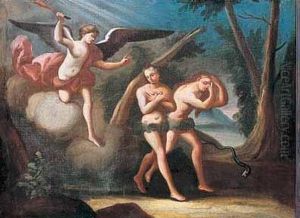Andrea Barbiani Paintings
Andrea Barbiani was an Italian painter of the late-Baroque period, active mainly in his native city of Rimini and the surrounding areas in the Emilia-Romagna region of Italy. Born in 1708 in Rimini, he was a part of an artistic family; his father, Francesco Barbiani, was also a painter. Andrea Barbiani's work is characterized by its vibrant color palette, dynamic compositions, and the influence of the grandiose style that was prevalent in the 18th century.
Barbiani was a student of Giovan Gioseffo Dal Sole in Bologna, which was a significant center for the arts and one of the key places where the Baroque style flourished in Italy. Under Dal Sole's guidance, Barbiani honed his skills and developed a mastery of the Baroque idiom, which was marked by dramatic effects of light and shadow, movement, and emotional intensity. After completing his studies, he returned to Rimini, where he became a prominent figure in the local art scene.
Throughout his career, Barbiani worked on numerous religious commissions, which were typical of the time for artists who specialized in painting. He produced altarpieces, frescoes, and other ecclesiastical works for churches in Rimini and other towns in the region. His paintings often depicted scenes from the life of Christ, the Virgin Mary, and the saints, rendered with a sense of grandeur and piety that was well-suited to the tastes of his patrons and the devotional climate of the era.
Among his notable works are the frescoes in the chapel of the church of Sant'Agostino in Rimini and his altarpieces in the church of Santa Maria dei Servi in Cesena. These works exemplify Barbiani's ability to combine the dramatic storytelling of the Baroque with a gentle and accessible humanity, a quality that endeared him to his contemporaries.
Barbiani's contributions to the art of the Emilia-Romagna region are significant, and his works are an integral part of the artistic heritage of the area. He passed away in 1779, leaving behind a legacy of art that continues to be admired for its beauty and historical value. Despite not being as famous as some of his Italian contemporaries, Barbiani's work provides insight into the regional variations of Baroque art in Italy and the ways in which local artists interpreted the grand themes of the period.


